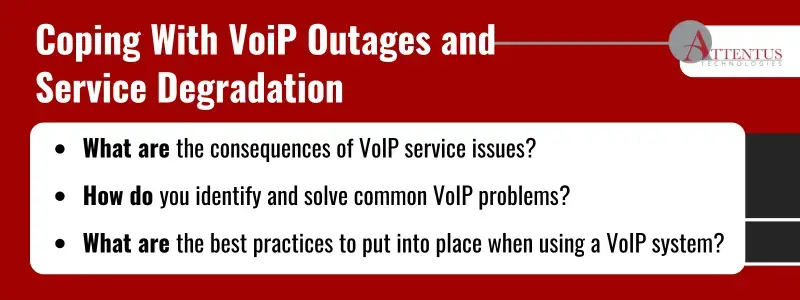As more businesses depend on VoIP communications, it’s important to know how to deal effectively with service issues, such as dropped calls and complete outages

More businesses are adopting voice-over-internet protocol (VoIP) phone services because they offer lower costs than traditional landlines, can be used anywhere with a broadband internet connection, and provide greater flexibility.
However, as dependence grows, so do the consequences of suffering VoIP outages or VoIP service degradation. Whether the problem is a total loss of service or a service-quality issue, such as poor voice quality, the consequences can include a loss of revenue, unhappy customers, and a tarnishing of brand image.
The problems could be the result of:
- Network connectivity issues
- Power outages
- Hardware failures
- ISP problems
- And more
Read the following to learn how to anticipate and deal with common voice-over-IP problems.
Impact of VoIP outages and service degradation
VoIP service issues can arise from various causes. Poor audio quality might result from insufficient bandwidth during high-traffic periods or packet loss. Dropped calls could be due to outdated firmware, while echo and feedback often stem from network latency or improper audio configuration.
And the list goes on.
Losing internet connectivity, a power outage, or hardware failure can cause total system outages.
All these issues can have severe consequences for your business. Losing connectivity with your clients and stakeholders can cause confusion, degrade your level of customer service, and harm your business’s operation. Financial damages can range from the immediate loss of business due to missed calls to the costs incurred in long-term outages.
Consistent communication issues can cause unhappy customers and damage your reputation.
Identifying and troubleshooting voice-over-IP problems
Time is of the essence when dealing with VoIP outages and VoIP service degradation. You want to get the service up and running quickly, limiting the damage caused.
If the cause of an outage or service issue is not immediately apparent, it’s advisable to have a checklist of troubleshooting steps, starting with the quickest and simplest tasks. For instance, verify that all system components are correctly connected and that your internet connection is active. Additionally, check if your ISP has issued any network alerts.
Next, you might want to check for router issues or see if your firmware needs to be updated.
Perhaps you need to verify your VoIP phone configurations or determine if there has been some hardware failure. Is your bandwidth sufficient to handle the current volume of traffic?
If you have advanced troubleshooting tools in-house, you could use diagnostic tools to measure latency, jitter, and packet loss.
Finally, suppose the problem is too serious or prolonged to be handled internally. In that case, you should contact your trusted I.T. service provider to get the answers and help you need quickly and efficiently.
Best practices for preventing VoIP service degradation
Prevention is always the best medicine to avoid VoIP outages and service degradation. To start, you or your managed service provider (MSP) should regularly monitor your network health, preempting issues before they arise.
You can adjust your quality of service (QoS) settings to prioritize traffic and ensure that the most important callers receive an acceptable level of VoIP service.
If you are in an area prone to power failures, you might want to invest in backup power solutions, such as an uninterruptible power supply (UPS). Or you might even get a backup ISP to ensure the continuity of communications isn’t interrupted by internet service outages.
Calls can also be routed to backup locations during outages. And, of course, when VoIP is integrated with staff smartphones, they can go to another location (like home) to work while the problems at the office are rectified.
Another important way to prevent problems is to regularly maintain your systems and schedule routine checks to identify potential vulnerabilities. Hardware and software should also be kept up to date to prevent issues.
An important pillar in prevention is employee training and awareness, ensuring they can recognize and report VoIP issues quickly. As a company leader, you must promote best practices for working with VoIP systems to minimize user-related problems.
Find the right partner for your VoIP requirements
For many businesses, the best way to cope with and get the maximum benefits of a VoIP system is to find the right MSP provider with a strong track record of setting up, maintaining, and successfully troubleshooting this communications technology for other clients.
They should offer a strong service level agreement (SLA), clearly spelling out what support you can expect to receive. They can also manage your VoIP system for you, addressing immediate issues and providing strategic guidance for long-term success.
They will do everything they can to ensure uninterrupted VoIP service, including setting up automatic failover systems to minimize downtime if a problem ever arises.
Attentus Technologies has become the VoIP provider of choice for many businesses in the Pacific Northwest. We can tailor packages to fit your business needs and offer flat-rate fees to keep your costs predictable.
Along the way, we can make your workforce more productive and give you the technological edge to compete with larger companies with enterprise-level features.
Contact us today so that our technology professionals can answer any questions you may have in a free assessment. Whether you want a reliable VoIP system set up and managed or have any other I.T.-related requirements, Attentus can help you achieve success through the best technological solutions.
